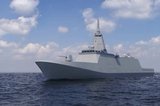New Irish OPV commissioned
The first of two Irish offshore patrol vessels (OPVs) being built by Babcock for the Irish Naval Service was officially named and commissioned on 17 May, following successful completion of sea trials and handover at Babcock’s Appledore shipyard in North Devon at the end of April 2014.
The first-of-class LÈ Samuel Becket was named in Dublin this weekend alongside the Samuel Beckett Bridge. The naming was followed by the commissioning ceremony.
LÈ Samuel Becket will be operational with immediate effect undertaking a range of duties including fishery protection, search and rescue, anti-pollution and maritime security duties, including vessel boardings. To conduct these operations a crew of 44, plus ten trainee berths, are available.
The approximately 90m, 2256 tonne OPV has autonomous engine rooms and is capable of a top speed of 23kts, and a range of 6,000nm at its cruise speed of 15kts on a single engine. The propulsion system utilises a diesel electric drive system providing a loiter function of up to 6kts. A comprehensive command, control and communications package is coupled to the main weapon; a 76mm gun, as well as two 20mm cannons and four general purpose machine guns.
The vessel is also equipped with configurable, serviced mission modules, with deck space to operate mission specific equipment, and to act as a mother ship for two fully independent fast pursuit Rigid Hulled Inflatable Boats. It is designed to provide an operational capability for many years of service in the North Atlantic, its main area of operation.
Commenting on the completion and handover Babcock Shipbuilding Director, Andrew Hamilton, said: ‘We are delighted and proud to have successfully built, trialled and delivered this first of class OPV to the Irish Naval Service. The success of this project has been brought about by the close co-operation of our customer, suppliers and industry. LÈ Samuel Beckett demonstrates that a commercial build coupled with commercial off the shelf equipment can give a high level of capability within the budgeted cost.’
Keel laying for the second OPV took place in November last year, with float-up scheduled for early November 2014 and sea trials and delivery taking place in early 2015.
More from Naval Warfare
-
![NATO tests use of “undetectable, jam-proof” laser communication in maritime scenarios]()
NATO tests use of “undetectable, jam-proof” laser communication in maritime scenarios
As part of its effort to better prepare its capabilities for operations in contested and congested scenarios, NATO evaluated a Lithuanian ship-to-ship terminal designed to not be susceptible to enemy interference.
-
![Mitsubishi eyes future with Australia’s Mogami selection]()
Mitsubishi eyes future with Australia’s Mogami selection
With Australia’s selection of the Mogami-class for Project Sea 3000, Mitsubishi is investigating local production in the next decade as potential export opportunities emerge.
-
![Thales’ new Sonar 76Nano could equip UK Royal Navy on anti-submarine warfare missions]()
Thales’ new Sonar 76Nano could equip UK Royal Navy on anti-submarine warfare missions
The new sonar is designed to equip uncrewed underwater vessels, with the potential to be used by the Royal Navy for its Atlantic Bastion and Atlantic Net missions.






















